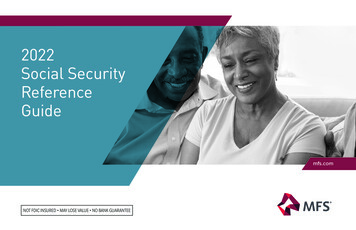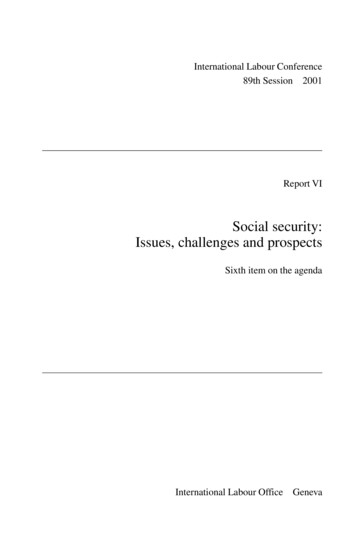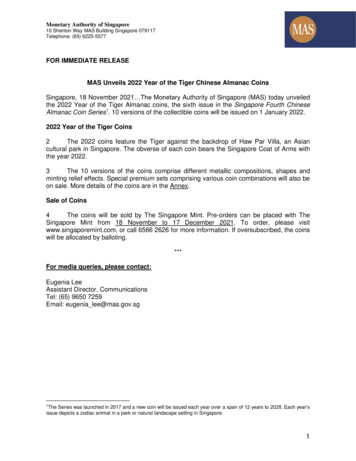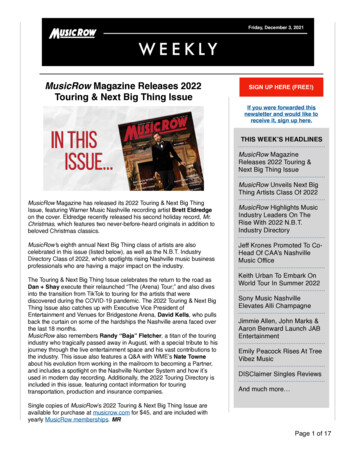
Transcription
enceGuideGuidemfs.commfs.comNOT FDIC INSURED MAY LOSE VALUE NO BANK GUARANTEE
SOCIAL SECURITY REFERENCE GUIDE
Table of contentsImportant ages1 Full Retirement Age (FRA)1 Milestone agesRetirement benefits2 Requirements to qualify for Social Security retirement benefits2 Retirement benefit increases and decreases3 Primary insurance amountAverage and maximum benefits4 Cost of living numbers for 20224 Earnings testSpouse and survivor comparisons5677Spousal percentages and key factsSurvivors percentages and key factsLength-of-marriage requirementsKey facts comparisonSpousal benefits8 Coordinating spousal and retirement benefits8 Requirements to restrict application to spousal benefits onlySurvivors benefits9 Widow(er) limit9 Widow(er) switch-up options10 Types of widow(er) benefitsDivorcee benefits11 Requirements to receive a divorcee benefit12 Remarriage (applicable for divorcees and widow(er)s)Government employees13 Windfall Elimination Provision and Government Pension Offset14 Windfall Elimination Provision Adjustment Based on Years of Substantial Earnings15 Federal retirement plans16 Military and railroad retirement plansDisability benefits17 Recent work test17 Duration of work test for disability benefits18 Social Security Disability Insurance (SSDI) versus Supplemental Social Insurance (SSI)Family benefits19 Eligibility for family benefits19 Maximum family benefitsDeferred and executive compensation20 Nonqualified deferred compensation and executive compensationTaxes21 Determining the taxable portion of Social Security22 Combined income22 FICA taxesMedicare23 Medicare taxes on earnings23 Medicare, Social Security and HSA nuances24 Medicare Part B and D premiums for 2022
IMPORTANT AGESFull Retirement Age (FRA)RETIREMENT ANDSPOUSAL BENEFITSYEAR OF BIRTH66 YEARS66 YRS 2 MOS66 YRS 4 MOS66 YRS 6 MOS66 YRS 8 MOS66 YRS 10 MOS67 YEARS1943–1954195519561957195819591960 Milestone ages5055Catch-up contributions for IRA, 401(k), 403(b) and otheremployer sponsored retirement plansPenalty-free withdrawals from governmental retirement plansfor public safety employees who are separated from serviceDisabled spouse eligible for Social Security survivors benefitPenalty-free withdrawals from 401(k) if separated from serviceAdditional contributions for Health Savings AccountsMedicare beginsHSA penalty-free withdrawals for nonqualified medicalexpenses* (qualified medical expenses are tax free)66Full Retirement Age for retirees born 1943–1954Maximum spousal benefits for spouses born 1943–1954Maximum survivors benefits for survivors born 1945–195667Full Retirement Age for retirees born 1960 or laterMaximum spousal benefits for spouses born 1960 or laterMaximum survivors benefits for survivors born 1962 or laterMaximum Social Security retirement benefit591/2Penalty-free withdrawals from IRA and retirement plansIn-service distribution if plan permits60Minimum Social Security survivors benefits7062Minimum Social Security retirement benefitsMinimum Social Security spousal benefits72Sources: Social Security Administration, IRS.165SOCIAL SECURITY REFERENCE GUIDERequired minimum distributions for traditional IRAs andsome retirement plans*** Please contact a tax advisor for information on qualified medical expenses.** The SECURE Act changed the required beginning date of RMDs for those whoattain age 70½ in 2020 or later to age 72.
RETIREMENT BENEFITSRequirements to qualify for Social Security retirement benefits4035You must work for at least 40 quarters to beeligible for Social Security retirement benefitsYour Social Security retirement benefits areaveraged over your 35 highest-earning yearsRetirement benefit increases and decreasesFull Retirement Age 6632.0%Full Retirement Age 5.0%-25.0%-30.0%Source: Social Security Administration.2
RETIREMENT BENEFITSPrimary insurance amount (PIA)PIA is the Social Security retirement benefit at Full Retirement Age (FRA). It is the sum of three separate percentagesof average indexed monthly earnings (AIME). For 2022, the percentages (bend points) are shown below.BEND POINT 1BEND POINT 2 90% of the first 1,024 of AIME 3,500First bend pointbegins at 0 3,00090%nBEND POINT 332% of AIME over 1,024and through 6,172 n15% of AIME over 6,172100%80% 2,50060%PIA Amount 2,000Second bend pointbegins at AIME 1,024 1,50040%32% 1,000Third bend pointbegins at AIME 6,172 50020%15% 00% 0 3,000 6,000PIA (primary insurance amount retirement benefits at Full Retirement Age)Replacement rateBend point percentage of AIME3SOCIAL SECURITY REFERENCE GUIDE 9,000 12,000AIMEReplacement Rate and Bendpoint %n
AVERAGE AND MAXIMUM BENEFITSCost of living numbers for 2022Earnings requirement to qualifyfor Social Security creditsWork and Social Security (earnings test)*Affects any Social Security benefit received before Full Retirement Age (FRA)EMPLOYEE:SELF-EMPLOYED: 1,510 6,040per quarterper calendar yearAGE2022 EARNINGS LIMITSUnder FullRetirement Age forthe full year 19,560Reach FullRetirement Ageduring 2022 51,960( 1,630 per month)**WITHHOLDING 1 in benefitswithheld for every 2 in earningsabove limitMaximum taxable earningsSOCIAL SECURITY:MEDICARE: 147,000NO LIMIT( 4,330 per month)** 1 in benefitswithheld for every 3 in earningsabove limitAverage and maximum monthly benefits (2022)MAXIMUM MONTHLYRETIREMENT BENEFITAT FULL RETIREMENT AGEAVERAGE MONTHLYBENEFIT FOR RETIREDWORKERAVERAGE MONTHLYWIDOW(ER)BENEFITAVERAGE MONTHLY BENEFITFOR RETIRED COUPLEWHO BOTH WORKED 3,345 1,657 1,553 2,753*Earnings test applies to any benefit (retirement, spousal, survivors, divorcée) received before Full Retirement Age. If married, Social Security looks at the wages of the spouse receiving Social Security benefit(not their joint income). Social Security only considers wages earned after you start Social Security. Earnings test is based on earned income only. Dividend, capital gains, rental income, distributions from IRAsand workplace retirement plans, etc. may not be counted as earned income. Severance pay is counted as earned income, unemployment benefits are an entitlement benefit and not counted as earned income.Please contact a qualified tax advisor for more information on earned income.**Special earnings monthly limit may apply the first calendar year. This limits monthly earnings to 1,630 ( 4,330 if turning FRA in 2022) starting in the month Social Security benefit begins and ending in December (or the month you turn FRA if turning FRA in 2022). If earnings exceed 1,630 ( 4,330 if turning FRA in 2022) in any remaining month of the calendar year (remaining month until turning FRA if turning FRAin 2022), you won’t be entitled to any benefit for that month. In the second year, the SSA applies the annual earnings limit.4
SPOUSE AND SURVIVOR COMPARISONSSpousal percentagesFull Retirement Age 66FRA for spousal benefits is age 66 for anyoneborn 1943 to 1954. Itincreases by two monthsfor every year from 1955to 1959. FRA is age 67 foranyone born 1960 .35.0%37.5%32.5%62 YEARSFull Retirement Age 6741.7%35.0%45.8%37.5%64 YEARS63 YEARS50.0%41.7%65 YEARS45.8%66 YEARS50.0%67 YEARSAge when you claim the spousal benefitSpousal benefits key factsREQUIREMENTS TO RECEIVE A SPOUSAL BENEFITn Must be currently married to your spouse for one year (ten yearsif divorced)n Your spouse must be receiving their retirement or disability benefitn Available even if you didn’t workIF BOTH SPOUSES WORKEDn Generally receive greater of your retirement or spousal benefit(possible exception if born on or before 1/1/1954; see page 8)n Only one spouse can receive a spousal benefitSource: Social Security Administration5SOCIAL SECURITY REFERENCE GUIDESPOUSAL BENEFIT CALCULATIONn Amount is based on your spouse’s benefit at their FullRetirement Age (regardless of your spouse’s age whenyour spouse claimed their Social Security benefit)n Percent is based on your age when you applyCLAIMING BEFORE FULL RETIREMENT AGEn If your spouse claims before/after FRA it doesn’t impacthow much you receive as a spousal benefitn If you claim before FRA, it reduces the total amount youreceive after your spouse applies
SPOUSE AND SURVIVOR COMPARISONSSurvivors percentagesFull Retirement Age 66FRA for survivors benefitsis age 66 for anyone born1945 to 1956. It increasesby two months for everyyear from 1957 to 1961.FRA is age 67 for anyoneborn 1962 .71.5% 71.5%76.3% 75.6%60 YEARS61 YEARSFull Retirement Age 6781.0% 79.6%85.8% 83.7%90.5% 87.8%62 YEARS63 YEARS64 YEARS95.3% 91.9%100% 95.9%65 YEARS66 YEARS100%67 YEARSAge when you claim the survivors benefit*Survivors benefits key factsREQUIREMENTS TO RECEIVE A SURVIVORS BENEFITn Must be married to your spouse for nine months (ten years if divorced)n Must be age 60 or older (50 if you are disabled) or have a “child-in-care” (see page 19)SURVIVORS BENEFIT CALCULATIONn Amount is based on benefit deceased spouse was receiving (see page9 for more information)n Percent is based on how old you are when you apply for the survivorsbenefitSource: Social Security Administration.EVENTS BEFORE FULL RETIREMENT AGEn If you claimed your retirement or spousal benefit before FRA,you are still eligible for the maximum survivors benefitn If the deceased passed away before FRA without claiming, thesurvivors benefit is based on what the deceased would havereceived at their FRAn If widow is between ages 60 and 70, widow may be eligibleto start with one benefit and switch to the other (see page 9)n The earnings test affects any benefit received before FRA* If the deceased claimed before their FRA, there is a special calculation for the surviving spousecalled the widow(er) limit. See page 9.6
SPOUSE AND SURVIVOR COMPARISONSLength-of-marriage requirementsSPOUSAL BENEFITn One continuous year just before filing for benefitsSURVIVORS BENEFITn At least the nine months before the worker diesDIVORCED BENEFITn 10 continuous yearsCHILD-IN-CARE BENEFITn No length-of-marriage requirementsKey facts comparison (for married couples and divorcees)MAXIMUM PERCENTIF YOU CLAIM YOUR RETIREMENT BENEFIT BEFORE FRA**n Spousal: 50% of your spouse’s FRA benefitn Spousal: reduces your spousal and retirement benefitn Survivors: 100% of the deceased’s benefit*n Survivors: no impact; percent is based on your ageAMOUNT BASED ONwhen you claim the survivors benefitn Spousal: Your spouse’s FRA benefitIF YOUR SPOUSE CLAIMS THEIR BENEFIT BEFORE FRAn Survivors: Your spouse’s benefit at death (if they diedn Spousal: no impact because the spousal benefit isbefore claiming; based on the greater of their FRAbenefit or what they would have been entitled to at death)based on your spouse’s FRA benefitn Survivors: reduces survivors benefit because survivorsbenefit is based on when the deceased claimed*See page 9 if deceased claimed before FRA.Source: Social Security Administration.7SOCIAL SECURITY REFERENCE GUIDE** Earnings test applies to any benefit received before Full Retirement Age.
SPOUSAL BENEFITSCoordinating spousal and retirement benefitsHAS YOUR SPOUSE APPLIED FOR THEIR RETIREMENT BENEFIT?YESNOnYou receive the greater of your retirement or the spousal benefitException: If you were born on or before 1/1/1954,you may be eligible for restricted application.nStart with your retirement benefitWhen your spouse applies: May step up to spousal (if greater)If you receive a reduced retirement benefit, yourspousal benefit is also reduced.*n* The Social Security Administration (SSA) pays out your retirement benefit first. When your spouse applies, the SSA tops off your current amount with an excess spousal benefit. The excess spousalbenefit (your max spousal) - (your retirement benefit at FRA). The excess spousal benefit is further reduced if you are under FRA when your spouse applies. After your spouse applies, the new totalamount (your current benefit) (excess spousal benefit).Requirements to restrict application to spousal benefits onlyRESTRICTED APPLICATION OVERVIEWRESTRICTED APPLICATIONREQUIREMENTS FOR RESTRICTED APPLICATIONnYou are born on or before 1/1/1954*n You apply at age 66 or olderRequirementsfor Restricted Applicationn Your spouse is receiving retirement or disabilitybenefit**Born on or before 1/1/1954*Apply at age 66 or olderSpouse applied for retirement benefit**Switch to retirement benefit plus8% annual accrual at any timebetween ages 66 and 70Start with spousal benefit at age 66 * If born after January 1, 1954: receive greater of retirement or spousal benefit.** Restricted application is available even if your spouse is receiving a reduced retirement benefit or born after 1/1/1954. The age 66 and birth date requirements are only for the spouse who wants to electThe Retirement Benefit will accrue in value by 8% per year from age 66 to age 70restricted application.*Clients who were born after 1/1/1954 will not be able to restrict their application to spousal benefits only. When they apply, they will receive the greater of their retirement or spousal benefit.or field and suspended by April 29,2016**8
SURVIVORS BENEFITSDeceased claimed before passing*Deceased did not claim before passingDeceased claimed before Full Retirement Age (FRA)Deceased passed away before Full Retirement Age (FRA)Widow(er) limit may apply**Widow(er) benefit based on deceased’s retirement benefit at FRA**Deceased claimed at or after Full Retirement Age (FRA)Deceased passed away at or after Full Retirement Age (FRA)Widow(er) benefit based on amount deceased was receivingat death**Widow(er) benefit based on deceased’s retirement benefit at FRAplus any credits**Widow(er) limitUse this formula if the deceased claimedbefore FRASURVIVING SPOUSE RECEIVES LESSER OF:GREATER OF:Widow(er)’s percent based off deceased’s FRAbenefit. See page 6 for widow(er)’s percent.Benefit deceased was receiving at death82.5% of deceased’s FRA benefitWidow(er) switch-up optionsOPTION12OPTIONStart with reduced survivors benefitas early as age 60Switch to retirement benefit at anytime between ages 62 and 70Start with reduced retirementbenefit as early as age 62Switch to survivors benefit at any time* If the deceased was receiving disability benefits, the survivor percent is based on the deceased’s disability benefit.** Adjusted for survivor’s age at time of filing for survivors benefit.Earnings limit applies to any benefit received before Full Retirement Age.Source: Social Security Administration.9SOCIAL SECURITY REFERENCE GUIDE
SURVIVORS BENEFITSTypes of widow(er) benefitsDefinitionAGED WIDOW(ER)CHILD-IN-CARE WIDOW(ER)DISABLED WIDOW(ER)Age 60 or olderHas a child in care under 16 ordisabledAge 50–59 and disabledWorker died fully insuredWorker died fully insuredWorker died fully or currently insuredMarital statusUnmarried or remarriedafter age 60If divorced, marriage lasted 10 yearsUnmarriedUnmarriedIf divorced, marriage does notneed to equal or exceed ten yearsOr remarried after age 50and after onset of disabilityIf divorced, marriage lasted 10 yearsMaximumbenefitFactors thatmay affectbenefit amount100% of deceased’s benefit75% of deceased’s benefit at FRA71.5% of deceased’s benefit at FRAEarnings testEarnings testEarnings testReduced if widow(er) claims before FRAFamily maximum (150%–187.5%of deceased’s benefit at FRA)Widow(er) limit may apply if deceasedclaimed before FRAIncreased if deceased claimed after FRAEarnings limit applies to any benefit received before Full Retirement Age.10
DIVORCEE BENEFITSRequirements to receive a divorcee benefitMinimum age for benefitPercentLength of marriageYour currentmarital statusYour formerspouseSPOUSALSURVIVORS62 or older60 or older (50 if you are disabled)32.5%–50% of ex-spouse’s FRA benefit71.5%–100% of deceased’s benefit10 consecutive years10 consecutive yearsUnmarriedUnmarried or remarried after age 60Former spouse must be age 62 or disabledFormer spouse must qualify for retirement ordisability benefitsFormer spouse does not need to apply for aretirement benefit*If both spouses workedGenerally receive greater of your retirementor spousal benefitReceive greater of your retirement or deceased’sretirement benefitSwitch upOnly available if you were born on or beforeJanuary 1, 1954Start with reduced survivors, switch to retirementOr, start with reduced retirement, switch tofull survivorsEarnings limit applies to any benefit received before Full Retirement Age.*Must be divorced for two consecutive years (if divorce was less than two years ago, former spouse needs to apply in order for you to receive a spousal).Source: Social Security Administration.11SOCIAL SECURITY REFERENCE GUIDE
DIVORCEE BENEFITSRemarriage (applicable for divorcees and widow(er)s)n If your former spouse remarries, it does not affect your divorcee benefits.n If you remarry you usually forfeit benefit off the first marriage. Two exceptions: Second marriage ends (through divorce, annulment or death), you may become re-entitled to benefits off the first marriage** You remarry after 60: forfeit spousal benefit off first spouse, but retain the survivors benefit off themREMARRYBEFORE AGE 60REMARRYAFTER AGE 60Forfeit spousal benefitoff former spouseForfeit survivors benefitoff former spouseForfeit spousal benefitoff former spouseKeep survivors benefitoff former spouse*SECONDMARRIAGE ENDSBecome entitled to benefitsoff first marriage *** Receive greater of spousal/survivors benefit of current spouse, your retirement benefit or survivors benefit of former spouse.** If first marriage ended due to divorce, assumes marriage lasted ten consecutive years before divorce. If first marriage ended due to death of spouse, the marriage must have been in existence fornine months before the death of the spouse.12
GOVERNMENT EMPLOYEES NOT COVERED BY SOCIAL SECURITYWindfall Elimination Provision and Government Pension OffsetWINDFALL ELIMINATION PROVISION (WEP)GOVERNMENT PENSION OFFSET (GPO)Who it affectsYou worked in a position that didn’t payinto Social Security and you also workedin the private sector.You worked in a position that didn’t payinto Social Security; your spouse workedin the private sector.What itmay reduceYour retirement benefitSpousal benefit based off of youSurvivors benefit off you is not reducedSocial Security spousal benefit you receiveoff your spouseSocial Security survivors benefit you receiveoff your spouseCalculationFirst bend point of PIA may bereduced from 90% to 40% (see page 3)Reduce Social Security spousal/survivorsbenefits off your spouse by two-thirds ofgovernment pension 512 per month if you turn age 62 in 2022May fully or partially eliminate Social Securityspousal and survivors benefitMaximumreductionReduction cannot exceed 50% of the amount of thepension received from noncovered employmentWEP does not apply to benefits from foreign Social Security systems that are based on a “totalization” agreement with theUnited States.You are subject to WEP and GPO even if you take a lump sum. In this case, the lump sum will be prorated to determine themonthly pension amount.Source: Social Security Administration.13SOCIAL SECURITY REFERENCE GUIDE
GOVERNMENT EMPLOYEES NOT COVERED BY SOCIAL SECURITYWindfall Elimination Provision Adjustment Based on Years of Substantial Earnings*PERCENT OFFIRST BENDPOINT OF PIARECEIVED40%45%50%55%60%65%70%75%80%85%90%(SEE PAGE 3FOR MOREINFORMATIONON PIA)MAXIMUMMONTHLYBENEFITREDUCTIONSBY YEAR YOUTURN 62 20 YEARS21 YEARS22 YEARS23 YEARS24 YEARS25 YEARS26 YEARS27 YEARS28 YEARS29 YEARS30 YEARS2022 512.00 460.80 409.60 358.40 307.20 256.00 204.80 153.60 102.40 51.20 0.002021 498.00 448.20 398.40 348.60 298.80 249.00 199.20 149.40 99.60 49.80 0.002020 480.00 432.00 384.00 336.00 288.00 240.00 192.00 144.00 96.00 48.00 0.002019 463.00 416.70 370.40 324.10 277.80 231.50 185.20 138.90 92.60 46.30 0.002018 447.50 402.80 358.00 313.30 268.50 223.80 179.00 134.30 89.50 44.80 0.002017 442.50 398.30 354.00 309.80 265.50 221.30 177.00 132.80 88.50 44.30 0.00*Substantial earnings for selected years are 27,300 (2022), 26,550 (2021), 25,575 (2020), 22,050 (2015), 19,800 (2010), 16,725 (2005), 14,175(2000), 11,325 (1995), 9,525 (1990) 7,425 (1985), 5,100 (1980). See Social Security Publication “Windfall Elimination Provision” for more details.14
FEDERAL RETIREMENT PLANSFederal retirement plansDate of hireCIVIL SERVICE RETIREMENTSYSTEM (CSRS)CIVIL SERVICE RETIREMENTSYSTEM (CSRS) OFFSETFEDERAL EMPLOYEESRETIREMENT SYSTEM (FERS)Hired prior to 01/01/1984Rehired after a break in serviceof more than one year and withat least five years of creditablecivilian service by 1/01/1987Hired on or after 1/01/1984Or rehired after a break in serviceof less than one year from CSRSOr rehired after a break in servicegreater than one year but with lessthan five years of creditable CSRScivilian serviceOr transferred to FERS from CSRSSubject toWEP or GPOSocial SecuritycoverageWEP and GPONeitherNeither*NoYes. CSRS annuity computed undersame rules as other CSRS retirees.When eligible for Social Securitybenefits (usually at age 62), CSRSannuity is offset by value of SocialSecurity benefit earned during CSRSOffset service.Yes. For certain FERS employeeswho retire and are entitled toimmediate annuity before age62, OPM pays “retiree annuitysupplement” that substitutes forSocial Security part of FERS. It is paidonly until age 62, regardless of whenretiree applies for Social Security.* WEP: If an annuity based on CSRS service was transferred to FERS, WEP rules may apply to that portion. GPO: Must have elected to transfer to the FERS before 01/01/1988or during belated transfer period ending 06/30/1988. Employees covered by CSRS and who elected FERS coverage after 06/30/1988 must have five years of federal employmentcovered by Social Security to be exempt from the offset.Source: Office of Personnel Management.15SOCIAL SECURITY REFERENCE GUIDE
MILITARY AND RAILROAD RETIREMENT PLANSMilitary and railroad retirement plansMILITARYRAILROAD RETIREMENT BENEFITSRETIREMENTRETIREMENTMilitary pension does not affect Social Security benefits.Social Security benefits based on your earnings.Tier 1: Based on earnings an employee acquired underboth railroad and Social Security covered employment;uses Social Security formulabut with railroad age andservice requirements*Tier 2: Based on railroad earnings; similar in concept todefined benefit planCREDIT FOR MILITARY SERVICESince 1957, active duty (including active duty for training)covered under Social Security.Since 1988, inactive duty covered under Social Security.From 1957 through 2001, special earnings credits grantedfor periods of active duty or active duty for training. If activeduty was after 1967, extra earnings already on your record.SURVIVORS BENEFITSSocial Security Survivors benefits may affect benefitspayable under optional Department of Defense SurvivorsBenefit Plan. Check with Department of Defense or militaryretirement advisor for more information.SPOUSALTier 1: Spouse receives up to 50% of retiree’s Tier 1 basicbenefit.**Tier 2: Spouse receives up to 45% of employee’s Tier 2basic benefit.SURVIVORTier 1: Survivor receives up to 100% of deceased’s Tier 1benefit.**Tier 2 : Survivor may receive percent of deceased’s Tier 2amount.* Tier 1 benefits reduced by amount of any Social Security benefit paid on the basis of non-railroad employment. Tier 1 benefits also reduced for any Social Security benefit anemployee receives that is based on earnings of their spouse.** Tier 1 portion of spouse or survivor annuity is reduced for any Social Security benefit, even if Social Security benefit is based on spouse’s or survivor’s own earnings.Tier 1 portion of spouse or survivor annuity may also be reduced for receipt of federal, state or local government pension based on spouse’s or survivor’s earnings.Sources: Social Security Administration, Railroad Retirement Board.16
DISABILITY BENEFITSEarnings requirementfor disabilityRecent work testTest based on your age at the timeyou became disabledn DISABLEDBEFORE AGE 241.5 years of work required duringthe three-year period ending withthe quarter that disability begann DISABLEDBETWEEN AGES 24 AND 31Work required during half the timefor period beginning with quarterafter turning 21 and ending withquarter that disability begann DISABLED10987654321AT AGE 31 OR AFTERWork 5 years out of the 10-yearperiod ending with the quarterthat disability beganSource: Social Security Administration.17Test that you worked long enough under Social SecurityYears of work needed in order to qualify forSocial Security Disability benefitsIn general, to receive disabilitybenefits, you must meet twodifferent earnings tests:1) recent work test2) duration of work testDuration of work test for disability benefitsSOCIAL SECURITY REFERENCE GUIDEBEFORE 283032343638404244Age of disability4648505254565860
DISABILITY BENEFITSSocial Security Disability Insurance (SSDI) versus Supplemental Social Insurance (SSI)QualificationsFullRetirement AgeSOCIAL SECURITY DISABILITY INSURANCE (SSDI)SUPPLEMENTAL SOCIAL INSURANCE (SSI)Based on recent work historyMust have limited income and resourcesAt FRA, amount does not changeAssuming assets, income and life circumstancesdo not change, dollar amount will not changeFunding switches from disability trust fundsto retirement trust fundsMay entitle children and spouse to SocialSecurity benefitsDoes not entitle children and spouse to SocialSecurity benefitsHealthinsuranceMedicare after two years of disabilityMedicaidSurvivorsbenefitBased on deceased’s disability benefitNot availableDependents’eligibilitySource: Social Security Administration.18
FAMILY BENEFITSEligibility for family benefitsQUALIFYING EVENTCHILD-IN-CARE SPOUSE / WIDOW(ER)QUALIFICATIONS*CHILDREN QUALIFICATIONn Disablementn Unmarriedn Retirementn Younger than age 18n Deathn Or 18 to 19 years old and a full-timen Caring for child who is understudent (no higher than grade 12)age 16 or disabledn Benefits end if child-in-caren Or 18 or older and disabledspouse/widow(er) remarries(disability must have started before age 22)Maximum family benefits*If parentis disabledIf parentis retiredIf parentis deceasedCHILDREN’S BENEFITCHILD-IN-CARE SPOUSAL /WIDOW(ER) BENEFITFAMILY MAXIMUMUp to 50% of disability benefitUp to 50% of disability benefit100%–150% of worker’s PIAUp to 50% of full retirement benefitUp to 50% of full retirement benefit150%–180% of worker’s PIAUp to 75% of deceased parent’sbasic Social Security benefitUp to 75% of deceased parent’sbasic Social Security benefit150%–180% of worker’s PIAIF TOTAL AMOUNT PAYABLE TO ALL FAMILY MEMBERS EXCEEDS FAMILY MAXIMUM LIMIT, EACH PERSON’S BENEFIT ISREDUCED PROPORTIONATELY (EXCEPT RETIRED/DISABLED PARENT’S BENEFIT) UNTIL TOTAL EQUALS FAMILY MAXIMUM.*Earnings test applies to any benefit received before Full Retirement Age.Sources: Social Security Bulletin, Social Security Handbook, Social Security Administration.19SOCIAL SECURITY REFERENCE GUIDE
DEFERRED AND EXECUTIVE COMPENSATIONNonqualified Deferred Compensation and Executive CompensationThe chart below describes when the following could be credited as wages to the Social Security earnings record. Contact IRS for information on taxation.WAGES CREDITED TO SOCIAL SECURITY EARNINGS RECORDNQ Deferred Comp:No risk of forfeiturePayments to plan are wages for Social Security purposes when services are performed andamount deferred.NQ Deferred Comp:Risk of forfeiture lapsesat retirementAll past contributions to plan (or value of the plan), including any accumulated interest, are wagesin year of retirement.NQ Deferred Comp:Risk of forfeiture lapsesbefore retirementAll past contributions to plan (or the value of plan), including any accumulated interest, are wages inthe year the point is reached. If employee continues working, future employer contributions are wagesas they are paid to plan.Stock bonus planCount the fair market value of the stock if not tax exempt.Stock option planCount as wages the difference between the fair market value of stock at the time the optionis exercised and option price. Count in the period the option was granted.Net unrealizedappreciation (NUA)The portion that represents NUA and is attributable to employee contributions is viewedas a resource (not as wages).Sources: Social Security Bulletin, Social Security Handbook, Social Security Administration.20
TAXESDetermining the taxable portion of Social SecuritySINGLEMARRIED FILING JOINTLY 25,000 of combined income 32,000 of combined incomeUp to 50% of SocialSecurity benefits includedin income and taxed 25,000– 34,000 of combined income 32,000– 44,000 of combined income50%–85% of SocialSecurity benefits includedin income and taxed 34,000 of combined income 44,000 of combined incomeSocial Security benefitsnot included in incomeSources: IRS.gov, Social Security Administration.21SOCIAL SECURITY REFERENCE GUIDE
TAXESCombined incomeADJUSTEDGROSSINCOME NONTAXABLEINTEREST†1/2OF SOCIALSECURITY COMBINEDINCOMEWHAT COMBINED INCOME DOES NOT INCLUDEn Roth IRA and Roth 401(k)/403(b)n Life insurance proceedsn Qualified charitable distributionsn Inheritance and giftsn Nontaxable portion of pensions and annuitiesn HSA withdrawals for qualified medical expensesFICA ocial SecurityExamples may include municipal bond income, income from savings bonds to pay for higher education and deductions for qualified educational loans. This is not an all-encompassing list.* FICA and the earned income test are based on gross income before contributions to employer sponsored retirement plans, health insurance plans and other deductions that may reduce federal taxes.** Does not include Additional Medicare Tax of .9% on earnings over 200,000 ( 250,000 f
5 SOCIAL SECURITY REFERENCE GUIDE Spousal percentages FRA for spousal bene-fits is age 66 for anyone born 1943 to 1954. It increases by two months for every year from 1955 to 1959. FRA is age 67 for anyone born 1960 . 62 YEARS 63 YEARS 64 YEARS 65 YEARS 66 YEARS 67 YEARS 35.0% 32.










